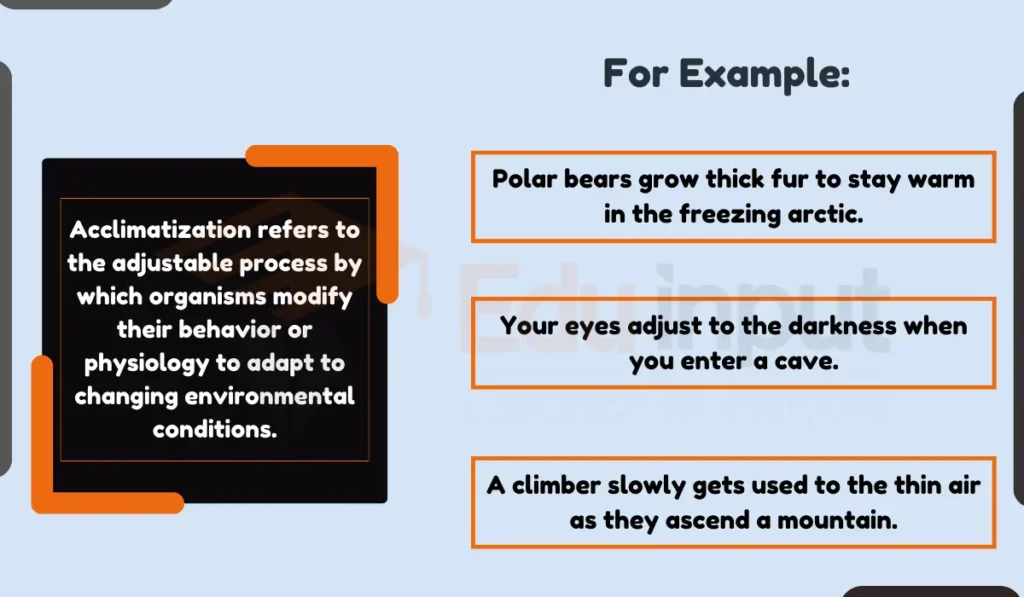Acclimatization-Definition, Mechanism, and Examples
What is Acclimatization?
Acclimatization refers to the adjustable process by which organisms modify their behavior or physiology to adapt to changing environmental conditions. These conditions can be due to temperature, altitude, humidity, pH, light, salinity, pressure, and exposure to specific chemicals.

Unlike adaptation, which involves evolutionary changes across generations, acclimatization occurs within a short timeframe, often within days or weeks, and is reversible.
Mechanisms of Acclimatization
The ability of organisms to acclimatize is facilitated by various mechanisms. These mechanisms can involve:
1. Physiological Changes
Increased red blood cell production: At high altitudes, the body increases red blood cell production to augment oxygen-carrying capacity and compensate for the lower oxygen availability.
Shivering and metabolic rate adjustments: In cold environments, shivering thermogenesis generates heat to maintain core body temperature. Conversely, sweating and vasodilation aid in heat dissipation in hot environments.
Hormonal adjustments: Hormones like adrenaline and cortisol are released in response to stress. It enables the body to adapt to challenging situations.
2. Behavioral Changes
Seeking shelter: Organisms may seek shelter from extreme weather conditions, such as seeking shade during excessive heat.
Altering activity patterns: Animals may become nocturnal in hot environments to avoid the heat of the day.
Modifying diet: Organisms may adjust their dietary intake to optimize energy expenditure and nutrient acquisition in response to environmental changes.
Examples of Acclimatization in Humans
Humans have incredible abilities to adjust to different environments. It allows us to survive in diverse conditions. Here are some common examples how humans acclimatize:
1. Altitude
Climbing high: Imagine climbing a mountain. As you go higher, the air gets thinner, making it harder to breathe. Your body can adapt. Over a few days, it will produce more red blood cells, which carry oxygen. This helps you feel better even with less oxygen.
Living high: People who live in high mountains like the Himalayas have amazing adaptations. Their bodies are better at using oxygen, and they have larger lungs to take in more air.
2. Temperature
Cold weather: People who live in cold places like Alaska have thick skin and a layer of fat that keeps them warm. They also wear special clothes and build shelters to stay warm.
Hot weather: People who live in hot places like Africa sweat a lot to cool down. They also wear loose clothing and stay in the shade.
3. Diving
Holding your breath: Free divers can dive deep and hold their breath for a long time. They train their bodies to use oxygen more efficiently and slow their heart rate. This allows them to stay underwater for minutes!
4. Diet
Eating local: People who live in different parts of the world eat different foods. This is because they eat what is available to them. For example, people who live near the ocean eat a lot of fish, while people who live in the desert eat a lot of dates.
Space food: Astronauts have to eat special food that is designed to be eaten in space. This is because there is no gravity in space, which can make it difficult to eat and digest food.
5: Time zones
People who rapidly travel across multiple time zones experience jet lag during acclimatization to the new local time at their destination. Their circadian rhythms regulating sleep/wake cycles take a few days to adjust.
In the meantime, they endure changes in sleep schedules, fatigue, hormone levels, and cognitive functioning.
Also read: How do Animals Acclimatize?







Leave a Reply